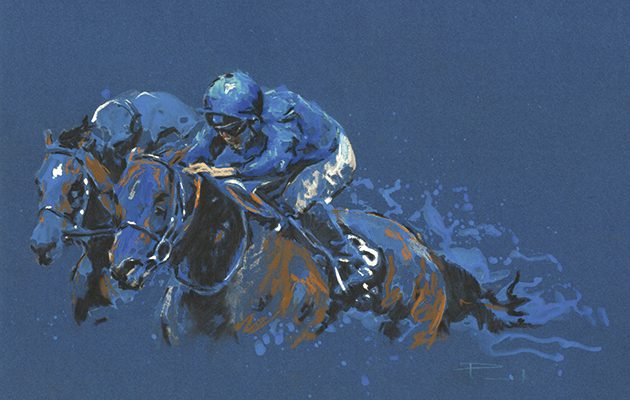From active service to wildlife and sporting art, Freddy Paske tells Janet Menzies how he plans to document a different type of war
Freddy Paske may have left one war behind when he left the Army but his sporting art has led him to documenting another. Janet Menzies speaks to Freddy Paske about his journey from active service to art.
For more sporting artists, Jim Starr has been influenced by his love of birds and the street art of London and Bristol. And through his sporting art, Sam MacDonald experiences catching the fish twice.
FREDDY PASKE
Just a few months after leaving the Army, Freddy Paske admits he is dazed to find himself exhibiting in Mayfair. “I had imagined that life as an artist would be all about having a morning coffee before a little gentle painting. I’m up at six every day getting on with organising administration, hangings, talking to clients – finding time to paint is a treat.”
Freddy Paske has never seen any disconnect between the military and art. But, coming from a Household Cavalry background, “It probably makes me the black sheep of the family. I think my Army recruiting officer must have had at least a small intake of breath when informed that my scholarship would be used to study history of art at Leeds University. In fact, the Army has been utterly supportive throughout my training and active service.”
Much of Paske’s active service was spent in Afghanistan, doing forward reconnaissance in command of a troop of 12 men. “Our role was to drive out into the desert for two or three weeks at a time on observation. The job was full on, so you don’t switch off, but once you are back the art is there. I ended up painting the subject matter and the people and places we had been.”
Paske’s work was exhibited by the Army Arts Society. He won the Serving Artist’s Award in 2015, making him a fully fledged war artist, like those he had studied for his thesis. One of Paske’s personal heroes, the sporting artist Snaffles, served in the First World War. Snaffles’ print That far, far-away Echo depicts a soldier in the trenches day-dreaming of hunting, it reminds us that sporting and military art often come together. Sporting and wildlife art was the direction Paske took when he left the Dragoons.
FREDDY PASKE: RACING ART
One of his first projects was inspired by his girlfriend’s racing tips. “She is knowledgeable about horse-racing and was discussing the likely winners at the Cheltenham Festival. I wanted to do some art that was immediate and to combine that with using the tremendous potential of social media to be creative and quick.” So Paske concentrated on capturing the fancied horses before and during the races. He included success on all levels, including such bookies’ ruins as Cue Card, Sprinter Sacre and Thistlecrack. “Not every fancied horse I painted came in,” says Paske. “For me, it was about catching the urgency of the moment and passing it on in real time through social media.”
Whether it is horses or wild animals, Paske’s work is full of movement. His latest exhibition is called Animals in Motion. “I have been influenced by many contemporary sporting artists, as well as the great painters. My finished work is often as much about what I haven’t depicted as what I have – the gaps in between. For example, a recent painting of a tiger looks as if I have painted the stripes. But actually they appear from where I have let the background come through.”
Paske’s racehorses show a similar economy and fluidity of brushwork. The impression of speed is increased by half-formed lines that capture the fleeting glimpse of the horse as it speeds by racegoers. The technique is reminiscent of Degas’ use of partial compositions in response to early photography. Paske responds to the modern observer’s digital media view of the world.
FREDDY PASKE: THE WAR AGAINST POACHING
For his next big project he is working with photographer Dave MacKay, another veteran. Together they are creating a multi-media documentation of a different war: the battle against wildlife poaching in sub-Saharan Africa. “We plan to join and live with anti-poaching units in Zambia,” explains Paske. “I want to concentrate on the people, though, rather than the animals. The men trying to prevent the poaching lead hard lives. And there is an added problem – the poaching is often done by others from within the same community. We want to use my painting and Dave’s photography to give a real, unsentimental insight into what is going on. This is going to take some complex logistics as well as funding to get it done properly.”
So perhaps Paske’s original Army recruiting officer will be nodding in approval after all – this is a mission with a clearly defined objective and every chance of success.
See Freddy Paske’s work via social media and at www.freddypaske.com





